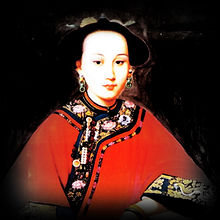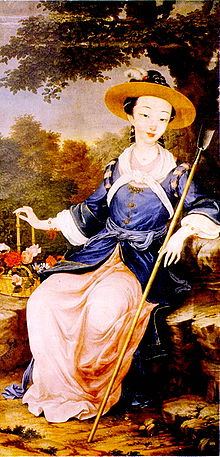- Fragrant Concubine
-
Khoja Iparhan
和卓.伊帕爾罕Spouse Qianlong Emperor Born 1734 Died 1788 (aged 53–54) The Fragrant Concubine (Chinese: 香妃; pinyin: Xiāngfēi; Uyghur: ئىپارخان / Iparxan / Ипархан) is a figure in Chinese legend who was taken as a consort by the Qianlong Emperor during the 18th century. Although the stories about her are believed to be mythical, they may have been based on an actual concubine from western China who entered the harem of the emperor in 1760 and who carried the court title of Rong Fei. Some people insist,[who?] however, that Imperial Consort Rong (whose original name may have been Maimur Azum) and Imperial Consort Xiang were different women. Han Chinese and Uyghur tellings of the legend of the Fragrant Concubine diverge greatly, and her experience represents a powerful symbol for both peoples. The story became greatly popular during the early 20th century and has since been adapted into several plays, films, and books.
Contents
The Legend of the Fragrant Concubine
Although accounts vary as to some details, the basic story amongst Han Chinese recounts the discovery by the Qianlong Emperor of an Uyghur girl named Iparhan, granddaughter of Apak Khoja, a local leader in the oasis city of Kashgar. Even more remarkable than her beauty was the scent her body naturally produced; captivated, the Emperor sought her as an Imperial Consort for his harem. She was given as a gift to the Emperor and carefully escorted all the way to Beijing, washing every day along the road in camel's milk to preserve her mysterious fragrance.
Upon her arrival to the imperial palace, the Fragrant Concubine, was gifted with a garden and a luxurious room of her own as a sign of the Emperor's devotion. Homesick and distraught, she remained disconsolate as the Emperor made ever-increasing efforts to recreate her distant village, building her a mosque, miniature oasis, and bazaar outside her windows in an effort to bring her happiness. Finally she relented and came to love him when he sent messengers to Kashgar to return with an jujube tree bearing golden fruit, and the Fragrant Concubine became the emperor's cherished consort until her death. An enduring symbol of national unity and reconciliation, her body was brought back to her home of Kashgar, where she is now entombed, in a procession of 120 bearers in a journey that took over three years.
The Legend of Iparhan
Contemporary Uyghur renditions of the legend are considerably less romantic. Stolen from her husband, a Muslim leader who had resisted the army of the Qing, and spirited away to Beijing, Iparhan arms herself with daggers up her sleeves, on guard against the hated advances of the Emperor. Some accounts cast her even more explicitly as a nationalist resistance figure who had risen during Uch Turpan Rebellion (1765) as one of the national leaders but was soon captured by Qing troops and delivered to Emperor. It was suggested that in addition to maintaining her purity Iparhan planned to kill the Emperor in revenge for his conquest of her homeland in Xinjiang.[citation needed] The Emperor, besotted, cannot resist the allure of her beauty, and in the end his mother the Empress Dowager arranges for her murder at the hands of loyal palace eunuchs in the face of Iparhan's unyielding resistance and the threat posed to her son.
Apak Khoja and Xiang Fei Tomb
The Afaq Khoja Mausoleum (mazar) located outside Kashgar was built in 1640 and, in addition to encompassing a larger complex that includes a functioning mosque and Qur'anic school, houses the coffins of five generations of the Apak Khoja family, including what is purported to be the body of the Fragrant Concubine. In fact, the real Rong Fei died of illness in 1788 and was buried in a royal tomb in Beijing; the legend of the Fragrant Concubine first became closely associated with the Kashgar tomb in the late 19th century, and the connection has since been officially established and endorsed through a proliferation of signs and guided tours. Critical Western academic observers have noted that the superimposition of the Fragrant Concubine myth on the preexisting tomb has effectively commercialized and trivialized what was once a major functioning Sufi shrine through the influx of tourism.[citation needed]
In fiction
- The character of Princess Fragrance in Louis Cha's Wuxia novel The Book and the Sword is loosely based on the Fragrant Concubine.
- The concubine also appeared as the character Han Xiang in the TV series Princess Pearl, based on the novel with the same title authored by Qiong Yao.
Bibliography
- Fuller, Graham E. and Jonathan N. Lipman. "Islam in Xinjiang" in Xinjiang: China's Muslim Borderland. Armonk, N.Y. : M.E. Sharpe Inc., c2004. (ISBN 0-7656-1318-2).
- Millward, James A. "A Uyghur Muslim in Qianlong's Court: The Meaning of the Fragant Concubine." The Journal of Asian Studies 53, no. 2 (1994): 427-58.
- Tyler, Christian. Wild West China: The Taming of Xinjiang. London: John Murray, c2003. (ISBN 0-8135-3533-6)
External links
Categories:- Qing Dynasty imperial consorts
- Uyghurs
- 1788 deaths
- Concubines
- 1734 births
Wikimedia Foundation. 2010.


